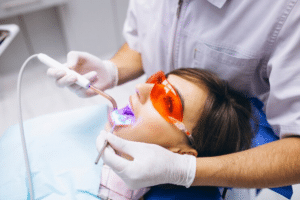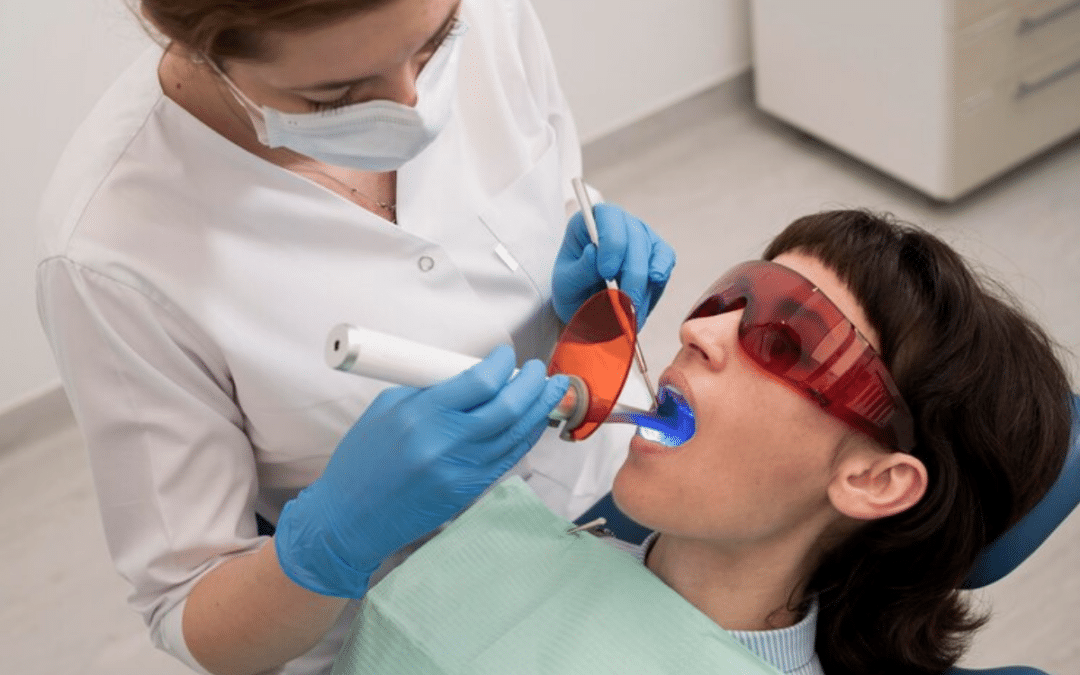In the realm of dental health, gum disease stands as a prevalent and potentially serious condition that affects millions worldwide. Traditionally, treatment often involved invasive procedures like scaling and root planing, which, while effective, could be uncomfortable and require longer recovery times. However, with advancements in dental technology, a new approach has emerged – laser dentistry. This innovative technique has revolutionized gum disease treatment, offering patients a minimally invasive and more comfortable alternative.
Laser dentistry utilizes focused light energy to precisely target and eliminate infected gum tissue while leaving surrounding healthy tissue untouched. By harnessing the power of lasers, dental professionals can achieve remarkable results with greater precision and efficiency. Moreover, the benefits extend beyond the treatment chair, as laser therapy often leads to faster healing times and reduced post-procedural discomfort. In this blog, we’ll explore its mechanisms, advantages, and its pivotal role in bidding farewell to gum disease.
Understanding Laser Dentistry
Laser dentistry involves the use of specialized dental lasers to perform a variety of dental procedures. These lasers emit concentrated beams of light energy that can be precisely controlled and directed to target specific areas of the mouth.
Types of Lasers Used in Dentistry
There are different types of lasers used in dentistry, each with its own unique properties and applications. Common types include diode lasers, erbium lasers, and carbon dioxide (CO2) lasers. Diode lasers are often used for soft tissue procedures, while erbium lasers are versatile and can be used for both soft and hard tissue treatments. CO2 lasers are primarily used for soft tissue surgeries.
How Laser Dentistry Works?
During laser dental procedures, the laser energy is absorbed by the water and pigments in the tissues, causing them to vaporize or undergo photothermal reactions. This precise interaction allows dentists to perform procedures with minimal damage to surrounding tissues. Laser dentistry offers several advantages over traditional methods, including reduced discomfort, faster healing times, and less need for anesthesia.
This field of dentistry has revolutionized the field of dental care, offering patients a more comfortable and efficient alternative to traditional treatments.

Benefits of Laser Dentistry for Treating Gum Disease
Laser dentistry offers several advantages when it comes to treating gum disease, also known as periodontal disease. Here are some of the key benefits:
Minimally Invasive Nature of Laser Treatment
Unlike traditional gum disease treatments that involve cutting and suturing, laser dentistry is minimally invasive. The laser energy precisely targets and removes infected gum tissue while leaving healthy tissue intact. This results in less trauma to the gums and reduces the risk of complications.
Reduced Discomfort and Pain During and After the Procedure
Since laser dentistry is minimally invasive, patients typically experience less discomfort and pain during and after the procedure compared to traditional methods. The laser’s precision allows for gentle treatment, minimizing trauma to the gums and reducing post-operative discomfort.
Faster Healing Times Compared to Traditional Methods
One of the most significant benefits of laser dentistry for treating gum disease is faster healing times. The laser’s ability to seal blood vessels and nerve endings as it works helps to promote quicker tissue regeneration and healing. This means less downtime for patients and a quicker return to normal activities.
Precision Targeting of Infected Areas
Laser dentistry allows for precise targeting of infected gum tissue without affecting surrounding healthy tissue. This precision helps to ensure thorough removal of bacteria and infected tissue, reducing the risk of reinfection and promoting better long-term outcomes for patients.
Effectiveness of Laser Dentistry in Gum Disease Treatment
Laser dentistry has been extensively studied and proven to be effective in treating gum disease. Here are some key points highlighting its efficacy:
Studies and Research Supporting the Efficacy of Laser Therapy
- Numerous clinical studies have demonstrated the effectiveness of laser therapy in treating gum disease.
- Research shows that laser treatment can significantly reduce bacteria levels in periodontal pockets, leading to improved gum health.
- Studies have also found that laser therapy results in less bleeding and inflammation compared to traditional gum disease treatments.
Comparison of Outcomes Between Laser and Traditional Treatments
- When compared to traditional treatments such as scaling and root planing, laser therapy has shown comparable or superior outcomes.
- Laser treatment can achieve similar or better results in terms of reducing pocket depths and improving the attachment of gum tissue to the teeth.
- Patients treated with laser therapy often report less discomfort during and after the procedure compared to traditional methods, leading to higher patient satisfaction rates.
Overall, the evidence from research studies strongly supports the effectiveness of laser dentistry as a valuable treatment option for gum disease. Its ability to achieve positive outcomes while minimizing discomfort makes it a preferred choice for many patients seeking treatment for gum disease.
Laser Dentistry Procedure for Gum Disease Treatment
Laser dentistry offers a minimally invasive approach to treating gum disease. Here’s what you can expect during the laser gum therapy procedure:
Step-by-Step Explanation of the Laser Treatment Process
- Preparation: The dentist will begin by thoroughly cleaning the teeth and gums and may administer local anesthesia for comfort.
- Laser Application: A specialized dental laser is used to precisely target and remove diseased gum tissue and bacteria from the periodontal pockets.
- Gum Reshaping: In some cases, the laser may be used to reshape the gums and promote better gum tissue attachment to the teeth.
- Sterilization: The laser’s energy also helps sterilize the treated area, reducing the risk of infection and promoting faster healing.
Precautions and Preparations Before the Procedure
- Patients may be advised to avoid certain medications or substances that can interfere with the effectiveness of the laser treatment.
- It’s essential to follow any pre-procedure instructions provided by the dentist to ensure optimal results and minimize risks.
What to Expect During and After Laser Gum Therapy?
- During the procedure, patients may feel minimal discomfort or sensation as the laser is used, but anesthesia helps manage any discomfort.
- After the treatment, patients typically experience little to no bleeding, swelling, or discomfort, allowing for a quicker recovery compared to traditional gum surgery.
- Patients can resume normal activities immediately after the procedure, although the dentist may recommend avoiding hard or crunchy foods for a few days to aid in healing.
Laser dentistry offers a revolutionary approach to treating gum disease, providing patients with minimally invasive, comfortable, and effective solutions. With its numerous benefits and proven efficacy, laser therapy is paving the way for a brighter, healthier future in dental care. Say goodbye to gum disease and hello to a confident smile!



